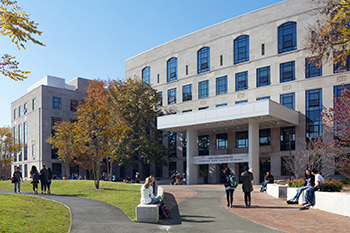Cambridge Rindge and Latin School Achieves LEED Gold
 CAMBRIDGE, Mass. — The U.S. Green Building Council (USGBC) recently awarded LEED Gold certification to the renovated Cambridge Rindge and Latin School (CRLS). Cambridge-based HMFH Architects and Milford, Mass.-based Consigli Construction collaborated on the $92 million project between June 2009 and September 2011.
CAMBRIDGE, Mass. — The U.S. Green Building Council (USGBC) recently awarded LEED Gold certification to the renovated Cambridge Rindge and Latin School (CRLS). Cambridge-based HMFH Architects and Milford, Mass.-based Consigli Construction collaborated on the $92 million project between June 2009 and September 2011.
The initial goal of the construction project was to “upgrade the aging HVAC system in the 400,000-square-foot complex,” said George Metzger, AIA, senior principal at HMFH Architects. Opportunities to address additional problems presented themselves as work began, however, and the project team adjusted the goals to “create a healthier learning environment and one better suited to the school’s educational program,” Metzger said. The team wanted to keep the school, situated on a visible civic block shared with the main library, recreation center and city park, in the same location to solidify its status as a significant element of the community.
The construction team kept several details in mind when working on the renovations. They used sustainable materials that were economically sound, designed for the long-term and would increase the quality of indoor air. Public spaces were also made brighter and easier to navigate with the removal of internal partitions that took up space and blocked visibility. A colorful terrazzo floor echoes the deco details on the 1932 portion of the building as well.
The fact that the construction team was renovating an occupied building posed a major problem during the renovation project. Available space in the city allowed the ninth-grade students to move off-campus for two academic years while the renovation process was underway. “With only three-quarters of the student population remaining in the building, the project team was able to isolate specific portions of the building for construction, without disrupting learning or compromising the safety of students and teachers,” Metzger said.
Another challenge the team faced was incorporating sustainable materials into the existing building. Metzger commented on this, saying, “While renovation (rather than new construction) is sustainable simply because an existing building is being used, it required thoughtful and creative approaches to replacing much of the inefficient infrastructure with systems that could be introduced into an existing structure that included concrete walls and ceilings in some portions of the complex.”
HMFH worked closely with the project’s mechanical engineer to incorporate a chilled beam heating and cooling system. This efficient system was easily installed in a structural environment that was not ideal. New and significantly more efficient lighting and plumbing fixtures, flooring and wall finishes were installed in the existing building as well.
Additional sustainable renovation techniques included installing rainwater barrels by the playground for water collection, diverting more than 95 percent of the construction waste materials away from landfills, using recycled and low-VOC materials and sustainable rubber flooring and installing operable windows.
The combination of these techniques decreased the school’s operating costs by more than $335,000 annually and reduced energy consumption by more than 1.3 million KWh of electricity, 44,000 therms of natural gas and 1.3 million gallons of water annually.
The renovated school, which shares its urban site with two other city-owned LEED Silver buildings — War Memorial Recreation Center and the Cambridge Public Library — completes the civic campus of sustainable buildings and aligns with the city’s sustainability initiatives.
“The high school project marked the end of a decade that saw almost constant construction on this site. Bound by two major city streets, the site remained open and accessible throughout all three projects. Now, with the completion of the third and final project, the citizens of Cambridge now enjoy a popular civic gem,” Metzger said.
